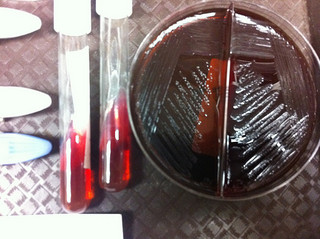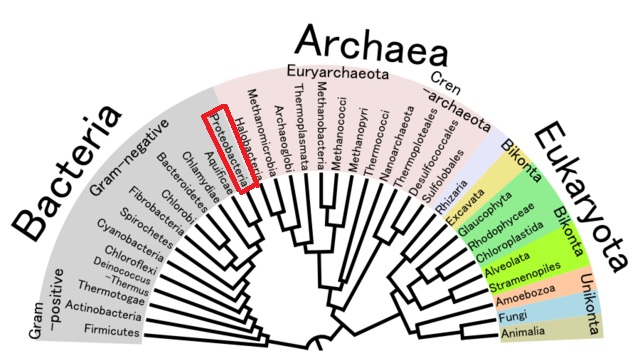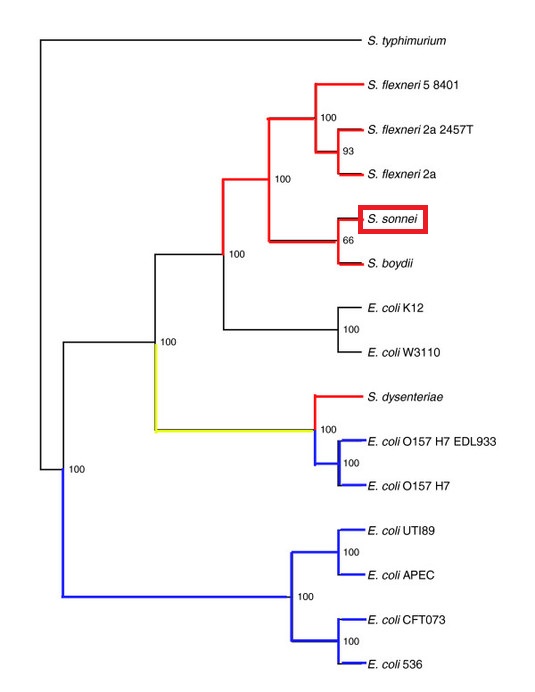Classification
Domain: Bacteria
Kingdom: Eubacteria
Phylum: Proteobacteria
Class: Gamma proteobacteria
Order: Enterobacteriales
Family: Enterobacteriaceae
Genus: Shigella
Species: Shigella sonnei
Shigella sonnei is named after the Danish bacteriologist Carl Olaf Sonne. The genus Shigella was named after Kiyoshi Shiga who first discovered it in 1898.
Domain and Kingdom
Shigella sonnei
fits into the
Domain and Kingdom Bacteria (Eubacteria) because members of
this group are unicellular, do not possess a nucleus, and have
peptidoglycan in their cell walls. An example of another
organism in this taxonomic category is
Streptococcus pyogenes.
Phylum
Shigella sonnei belongs
to the phylum
Proteobacteria because it is
gram-negative with the outer membrane mainly composed of
lipopolysaccharides. An example of another organism in this
taxonomic category is
Neisseria meningitidis.
Class
Shigella sonnei is
classified in the class
Gammaproteobacteria because it is comprised of
facilitative anaerobic and fermentative
gram negative
bacteria. An example of another organism in this taxonomic
category is
Legionella pneumophila .
Order
Shigella sonnei fits
into the Order Enterobacteriales because it is comprised of
rod-shaped,
facultative anaerobic,
gram negative bacteria occurring as plant or animal
parasites or as
saprophytes. An example of another organism in this
taxonomic category is
Salmonella.
Family
Shigella sonnei is
classified into the family
Enterobacteriaceae because members of this group grow well
at 37 degrees Celsius,
oxidase negative, and
catalase positive, and reduces nitrates. An example of an
organism in this taxonomic category is
Escherichia coli.
Genus
Shigella sonnei fits
into the genus Shigella because it only causes disease in
primates and no other animals. An example of an organism in this
taxonomic category is
Shigella flexneri.
Species
Classified as Shigella
sonnei because it can be differentiated from the other
types by
positive β-D galactosidase and
ornithine decarboxylase biochemical reactions.
In the phylogenetic tree above, Shigella sonnei can be found in the Domain Bacteria. This diagram then breaks the Domain Bacteria into Gram-positive and Gram-Negative bacteria. Shigella sonnei can be the Gram-Negative bacteria within the Phylum Proteobacteria. This is a cladistics representation; the most primitive organisms, such as Shigella sonnei, are on the far left of the tree and the organisms’ complexity becomes greater as read to the right. This diagram shows how all the Domains fit together on one tree.
In the phylogenetic tree above, Shigella sonnei is being evolutionary compared to E. coli. This tree was made based on 100 genes that were randomly selected from 1,214 E. coli K12 genes. All strains of Shigella have been created by E. coli. It also shows how the closest Shigella strain to Shigella sonnei is Shigella boydii. The main that separates these two types of Shigella is how many serotypes each has. Shigella sonnei had 1 where Shigella boydii has 23. The tree branches colored in blue lead toward a pathogenic E. coli strain where the red tree branches lead toward a Shigella strain.
Now that we have spent some time on how Shigella sonnei came to be, lets take a look at its habitat!


